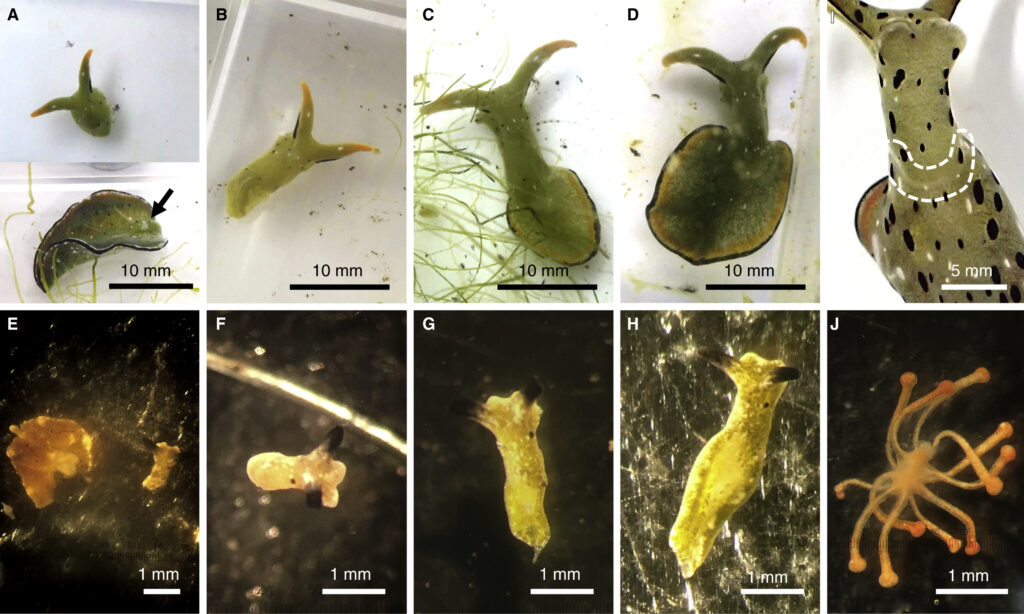CORRESPONDENCE| VOLUME 31, ISSUE 5, PR233-R234, MARCH 08, 2021 Current Biology
Extreme autotomy and whole-body regeneration in photosynthetic sea slugs (光合成ウミウシに見られる非常に稀な自己切断と体全体の再生)
Sayaka Mitoh* and Yoichi Yusa Nara Women’s University, Kitauoya-nishi, Nara 630-8506, Japan
*著者は、奈良女子大大学院人間文化総合科学研究科 博士後期課程1年三藤清香さんと遊佐陽一教授で、責任著者は三藤清香さんである。
*Current Biologyは、生物学(特に分子生物学、細胞生物学、遺伝学、神経科学、生態学、進化生物学)を対象とした学術雑誌である。1991年にCurrent Science groupによって創刊、2001年からはエルゼビアのCell Pressから発行されている。
Summary
Autotomy, the voluntary shedding of a body part, is common to distantly-related animals such as arthropods, gastropods, asteroids, amphibians, and lizards1,2. Autotomy is generally followed by regeneration of shed terminal body parts, such as appendages or tails. Here, we identify a new type of extreme autotomy in two species of sacoglossan sea slug (Mollusca: Gastropoda). Surprisingly, they shed the main body, including the whole heart, and regenerated a new body. In contrast, the shed body did not regenerate the head. These sacoglossans can incorporate chloroplasts from algal food into their cells to utilise for photosynthesis (kleptoplasty3), and we propose that this unique characteristic may facilitate survival after autotomy and subsequent regeneration.
自切は、節足動物、腹足類、棘皮動物(ヒトデなど)、両生類、爬虫類などの様々な動物によく見られる。 自切は一般に、付属肢や尾などの脱落した末端の体の部分の再生を伴う。 本論文では、鹿児島市で採集し、研究室で代々飼育している「コノハミドリガイ」と広島県尾道市の向島で採集した「クロミドリガイ」2種の嚢舌類のウミウシ(軟体動物:腹足類)における新しいタイプの自切を報告する。 驚いたことに、彼らは心臓全体を含む本体を自切し、新しい体全体を再生した(3週間程度)。 対照的に、(心臓を含む)身体は頭を再生しなかった。 自切はウミウシの頸部?の特定の位置で起きると考えられ、細い糸で軽く絞めると自切を誘導できる(糸でウミウシの頸部?を切断するわけではない)。これらの嚢舌類は、食物の藻類の葉緑体を自らの細胞に組み込んで光合成に利用することができ、この独特の特徴が自切後の生存とその後の再生を促進する可能性があることを本論文で報告する。
This sea slug cut off its own head—and lived to tell the tale https://www.sciencemag.org/news/2021/03/sea-slug-cut-its-own-head-and-lived-tell-tale. Science. doi:10.1126/science.abh4264
“It underscores the fact that still in the 21st century, we truly do not know what is possible in biology,”ウミウシのような複雑な動物の中では、このような大規模な再生は前代未聞です. ′′ 21世紀に入ってもまだ生物は何が可能なのか, 私たちは本当に知らない′′とストワーズ医学研究所の分子生物学者Alejandro Sánchez Alvarado博士は述べる。
